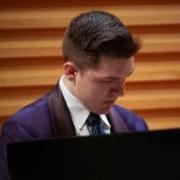All Activity
- Past hour
-
Vonias started following Legislation
-
"Legislation," is a work inspired by the government shutdown in, America. I'm so angry, I put to music all the words I can't say. The song is played over a vamp, free form. The saxophone chains melismatic ideas across the song. Other than
- Today
-

A hollow theme for Halloween (Fall 2025 competition)
Kvothe replied to therealAJGS's topic in Electronic
That is fine. what @Thatguy v2.0 is triue. All genres are welcome. Most composers here want their music to be perform. However, in the media world, that is far from the case. It still takes practice. It takes time to make solid demo. No rush. -
therealAJGS started following Kvothe
-
therealAJGS started following Undoubtedly Strange
-
therealAJGS started following Left Unexplained
-
therealAJGS started following Op.181 for piano (original composition for organ)
-
.thumb.png.1e2763f479362bbb522da50d31ef2e50.png)
A hollow theme for Halloween (Fall 2025 competition)
therealAJGS replied to therealAJGS's topic in Electronic
i used an ai because i have no idea how to write one -
.thumb.png.1e2763f479362bbb522da50d31ef2e50.png)
A hollow theme for Halloween (Fall 2025 competition)
therealAJGS replied to therealAJGS's topic in Electronic
Thanks! by the way, this isn't my normal software, my main one is FL studio. I also didn't know musecore was free, because it kept giving me pop-ups advertising the Premium version. -

A hollow theme for Halloween (Fall 2025 competition)
Thatguy v2.0 replied to therealAJGS's topic in Electronic
Hey dude Apparently some aren't aware you aren't using notation software. Don't worry about your score, your program isn't designed for that. You're writing music and that's all that counts, and we have ears so we can hear what you're doing. I used to use Cubase to write music, and I submitted a piece for a competition here some years ago and all people did was whine and cry about the score, asking me if it's playable. I tried explaining that I wrote it to be playable, but it was impossible to make the score it creates legible. I didn't win, and I knew I wouldn't, but who cares. I wrote something cool, and I still like it to this day. If you ever want to try musescore or something similar, it's free, and I'm sure if it's not already optimized for mobile, something exists that does or it's soon to be in the future. Those are designed with score creation at the forefront, and if you ever get the hang of it, you might learn about areas in music you otherwise wouldn't. If you decide against it or like what you use now, that's fine too. Most people in the world DON'T use notation software for writing music. This site mainly has people who write with notation software because they're writing for performers, but your music is just as welcome. This had all the Halloween elements, and instrument choice was great! I'm not giving out any scores, but you get one of these: 🎃 I like the chord change at 2:15 or so, it broke up the static harmony really well. Sounds like your in minor, know all the chords you can go to? Try other ones out if you're ever stuck on ideas, might give you new options for your harmony. Your ideas worked really well together, nice job on this! Be sure to vote 😄 -
Hello @Omicronrg9 @MK_Piano @UncleRed99 Thank you, my friend, for your generous comment. It must have taken your time to type all of these - which shows your pursue and love for music, as we all do on this community. But what are we pursuing in compositions? I really want to talk deeper in this matter, and please feel free to continue in this post.
-
Henry Ng Tsz Kiu started following Op.181 for piano (original composition for organ)
-
Ah, I caught that Toccata and Fugue in D minor Reference lol Subjectively, I feel this piece could've been made much more enjoyable to listen through all the way, had you made different choices with harmony, in this work! While I understand the goal is to capture "Halloween" as a theme, every bar in this score seems to have some level of dissonance. Especially in the "F" section. You begin with a nice, but lonely piano texture, then comes in the strings, like nails on a chalkboard, much like most of the piece presents itself, in the strings. In my humble opinion, I feel when it comes to music, even the music that's meant to elicit a feeling of unrest, suspense, or thrill such as the Halloween theme should represent, finding a way to balance out dissonance with consonance is a very important aspect in creating something that can be enjoyed by everyone, or utilized within other works of art such as film for example. Telling a clear story using melodic textures that are able to be naturally resonated with is Important, if you were to ask me. Otherwise, the score had interesting ideas that should be commended. I will have to agree with much of the feedback that Daniel @Omicronrg9 has left behind for you to review. Thank you for sharing! Melodies Themes Motives Harmony Chords Textures Form Development Structure Time Originality Creativity Score Presentation Instrumentation Orchestration Playability Execution of Given Challenge Taste 4 2 5 5 8 8 8 2 Average Score: 5.25
-
Quite a unique ensemble... 2x Pianos & 1x Violinist? Interesting... lol Melodies Themes Motives Harmony Chords Textures Form Development Structure Time Originality Creativity Score Presentation Instrumentation Orchestration Playability Execution of Given Challenge Taste 7 7 4 10 5 0 4 5 Average Score: 5.25 😉 I will try to return and elaborate on this score tally when I have time to do so. Thanks for sharing!!!
-
Melodies Themes Motives Harmony Chords Textures Form Development Structure Time Originality Creativity Score Presentation Instrumentation Orchestration Playability Execution of Given Challenge Taste 3 3 7 8 5 9 7 4 Average Score: 5.75 😉 I will try to come back here, when I have time to, to provide a more thorough explanation of my reasoning with this score tally. Thanks for sharing!!!
-
Fair enough. I suppose I didn't catch the underlying meaning or intent behind the notation. As you know, I was always a wind instrumentalist, not classically trained. So my interpretation of sheet music may differ from those who are classically trained. Although, I did mention that I can't see that as a "problem" and more so viewed it as a technicality. Which had no bearing on my final scoring of the piece! But thank you for clarifying that point 😉
-

2025 Halloween Competition - DANCE FROM THE SKELETON BALL (Submission)
MK_Piano replied to MK_Piano's topic in Chamber Music
@UncleRed99 I can understand some of the confusion. As this was created and submitted for this Halloween event, my original goal was to make a skeleton dance. I was explicit in conveying that in the title and the brief description of the work. For some context, yes, I did mean to use “Esultante” to convey a jubilee as you are hearing the music from this dance reach a close. We are hearing the music from this grand gala. However, what is “chaotic” to us is fun for them as the “DJ” or Host raises the energy to close the party. To your point about the articulation in the cello, there comes a point in performance practice where you find out that articulation markings also convey bowing information. There are multiple ways to play a staccato within the string family (on or off the string staccatos). The context of the works implies that they need to lift or bounce the bow off the string and attack for the slur with another, single-bow movement. In the context of the work, they will bounce between their C and G strings respectively. In terms of blurriness of the chromatic notes? Clarity and hearing each individual note is not the intention, as it is meant to convey a little “rush” or “wisp” motion into the downbeat(s). Thanks for the comments. -
What's up my boy. We've already spoken about this score privately. But I have to comment here, as well! I didn't mention the enjoyment of your use of the bVI chords in your transitions. Very tasteful and well placed. Pacing of the piece is very well executed. Also pleased to hear at mm.33 you found a way to make the playback work in your favor. 😉 a couple things to point out, from my perspective though. Your use of the term "Esultante" I feel is misplaced in this score, as a whole. That section is more reminiscent of chaos rather than "exultant," "jubilant," or "elated" (which is the definition of that term, from what I recall) which is but a small gripe, but a gripe nonetheless lol I also am questioning playability in some areas for Violin and Cello. I'm not a strings player, however, I would imagine some of the rhythms used in the rhythmic sections, and even in a couple areas of the melodic sections for either instrument, while they'd be physically playable, might not sound as it's written with any amount of ease. Not to say that it's not possible with practice, but for example, the Cello part, when ending a phrase in it's rhythmic areas, they're playing an eighth note followed by a sixteenth note chromatic triplet: I fear that this would come out more "muddy" than well articulated for many players, specifically being played in the lower register. Though, this is not a "problem", moreso a technicality, if we're being fair. But I digress. lol You can see my scoring chart + average score below, to conclude my thoughts on the score. Thanks for sharing, and I'm glad you decided to join us here at YCF 😉 Great work, and I know you'll keep on writing so I don't need to tell you, twice xD Melodies Themes Motives Harmony Chords Textures Form Development Structure Time Originality Creativity Score Presentation Instrumentation Orchestration Playability Execution of Given Challenge Taste 8 8 10 6 7 6 10 10 Average score: 8.125 😉
-
-
This one is most definitely "Halloween". The subtle use of that Gb Tritone / Cdim. chord suggestion in the piano, as a part of the eighth note phrases on the right hand staff really makes the listener get that uneasy feeling. Overall, I like this piece very much, and would even go as far as to say I'd like to see it performed live! I'm sorry that I don't have more to add in regards to this score, today. I'm strapped for time lately, trying to make rent, working around poor weather to make that happen. 😕 I'm attempting to comment on all the submissions for the competition, with something at least. I hope this will do 😅 Thanks for sharing! Melodies Themes Motives Harmony Chords Textures Form Development Structure Time Originality Creativity Score Presentation Instrumentation Orchestration Playability Execution of Given Challenge Taste 8 10 7 5 6 10 10 7 Average score: 7.87 😉
-
This is about half of a new slower part of the piece. I’m not sure at the moment how to incorporate it in the piece or whether to make a separate movement. All feedback is appreciated
-

2025 Halloween Competition - DANCE FROM THE SKELETON BALL (Submission)
MK_Piano replied to MK_Piano's topic in Chamber Music
Yeah, it feels nice to have someone else notice those decisions. In all honesty, I did not realize the Viola never had the melody until I did the A-minor Modulation lol So, I tried a solo Viola part at the section, but I know if played live, it was going to get lost in the heavy texture at Forte. So, I doubled it with the Cello to support as the Piano was doing the bass pattern. Also, 100% correct on the enharmonic spelling in the Viola, it was purely for voice-leading purposes versus trying to imply a different harmonic function. Thanks for the comment! 🙂 -

From Above, Now Below (Submission)
Henry Ng Tsz Kiu replied to Thatguy v2.0's topic in Chamber Music
Yo Vince my babe! I listen to this piece twice and I am gonna say that I think this is the best piece in the competition so far (of course @ferrum.wav still hasn't submitted his piece lol). The opening itself is already very captivating. The Reich-like repeating figure in the piano scares my 💩 out, and it gives me some Messiaen vibe too from his Quartet of the End Time. It reminds me very much of the rehearsal mark D of the 2nd mov of the work: The octatonic notes really captures the anxious mood well. The Glissando in b.13 intensifies the tendency of my 💩 to burst out from my ass, b.21 even more so, and I absolutely love the polyrhythm in b.20. Even though this section sounds very effective in portraying the horrible mood, structurally it's very tight with motivic usage and you have your materials under your control! The sabbath dance is even more wonderful. It reminds me of Bee's 6/8 fast section in his Grosse Fuge but with Halloween touch. I love the very low register you use for the piano right at the beginning as the unsettle bass of a dance. I would interpret the opening motive a motivic extension from the opening with wider intervallic usage. The melody in b.56 violin, despite sounding in a complety different context and mood, derives from the beginning bar, which shows how organized this work is despite its wonderful mood creation. And while I am typing this sentence the music turns to the contrasting section in b.64, which is another wonderful section with the subito p. The piano melody, harmonics in violin and viola, as well as the pizzicato cello (which the melody comes from the beginning of this section, b.46), combinied together creates a wonderfully eerie timbre. Wonderful development till b.90. And when I think the climax will come, you suddenly tone it down, have the piano playing the melody here, and add a wonderful counterpoint with a jazzy touch in b.96. This struggle between lightness and grotesque really enhance the drama of the work, just like the film "It was just an accident" I watched where the director added comedy touch to enhance the tragedy of the whole film. The polyrhythm, use of the high register of violin and cello and piano, very reasonable development of materials in this section is wonderful to listen to. After the slight "rest" in b.112 which resembles b.68, another great development follows with more instensified imitations and answering of motives in b.119,and after reaching the climax it moves fluently to the A' section in b.136 with a quicker tempo. The polyrhythm here is even more complicated and wonderful. Within the general mood of the piece, even the "normal" C major sounding in b.154 sounds weird. I love the sadness you reach in b.166 (in my favourite C sharp minor!). It doesn't sound out of context at all as it follows fluently from passages before! Next is the section in b.171. The transition to it with mood and tempo change is so coherent, and now it's the shortening of the motive with just the minor second left with octatonic key influence. I have nothing to say in this section given how you develop the climax in b.231, and then.... a random pause? Where do you learn the idea from haha!!!?? The ending is wonderful reminiscence of the beginning as well! I would give this piece the 1st place from all the pieces available now, given how wonderful this piece is from mood, treatment and development of materials, timbre, rhythm, structure... It's just so perfect itself and with the eerie elements in it it just adds as a bonus as a competition piece of a Halloween competition. You are too kind, it should be -100/10 as it's "so below" lol! Thx for sharing this wonderful music to us!!!!! Henry -
@Henry Ng Tsz Kiu Some of favorite composers are Chopin, Brahms,Tchaikovsky, Malher, Ravel, Debussy, and of course...we can not leave behind holts and others. So i want combine romanticism with modern harmony with traditional form. A real perfomace is not real in cards right now. But I am working towards that.
-
Hello @MK_Piano! I like the dark opening with all low registers from the strings! You mention Mozart in your programme notes. That G-A-B-C motive definitely reminds me of the opening of his D minor Piano Concerto K 466, as well as Beethoven's op.111 first movement. I like this light hearted dance, and the cello melody in b.13 which would later be reused in the Doloroso part. I like the B minor and nepolitan Db major chord in the Doloroso section, as it makes the music more unsettling, combining with the triplets, and it would be great if there are more polyrhythms here, like the one in b.43 to make the music rhythmically more unsettling! Personally I would want the Doloroso section develops a bit more as I feel like the modulation to F minor is a bit too early for me. But this is subjective in my part! For b.56 I may just write the viola part as Ab-Db to show the nepolitan chord, but I know that your G#-C# would like to show the upward resolve, as well as preventing a natural sign in the next bar's D so it's ok too. The modulation to A minor at the end makes the music brighter and I like how you vary the texture to get the music more exciting till the end! The ensemble writing here is almost perfect. One thing I would hope for is that you will give viola a chance to play the melody in solo! I always like its distinctive timbre as it doesn't get too stressed in its high register like cello, nor too hard in notes normally played by violin's G string. Thx for joining the forum and the competition! Henry
-
Hi @Kvothe! i quite like the pantonal opening, and the waltz at end is quite nice, mixing Tchaikovsky with some eerie touch. I actually feel a bit sad the rendition doesn't capture the col legno sound well enough! It will definiely sound much better with real instruments and create the ghostly mood. For me the piece can definitely be developed more extendedly, just like @UncleRed99 said. The ending sounds incomplete to me, as the whole waltz is a 16+8 structure. First you can definitely extend the 8 bar phrase to a 16 bar one, and you can add some contrasting sections within the waltz, possibly from materials in the pantonal to extend it a bit more. The opening for me can also extends longer for a more haunting mood portrayal. Second is the smoothness of different sections. There are 3 sections in the piece: the opening mysterious pantonal section, and then the 6/8 section, and then the waltz. Each of the sections sound isolated with each other and the transition, apart from the good col legno transition in b.41-44, sounds less smooth in b.17-18. I would suggest you at least add one more section to incorporate all of these presented materials together for a more completed synthesis and development of the piece! Thx for joining the competition and sharing your piece! Henry
- Yesterday
-
My fault, already fixed it
-
Exactly, my apologies! Already fixed
-

Dima's National Dance - 2025 Halloween Submission
Henry Ng Tsz Kiu replied to Dima's topic in Chamber Music
me too! Maybe @Dima you have to change the access right for your link in Google drive! Henry -
.thumb.png.8b5b433a341551e913a34392660bc95b.png)
Dima's National Dance - 2025 Halloween Submission
PeterthePapercomPoser replied to Dima's topic in Chamber Music
@Dima I can't access your links - it says access is denied.






